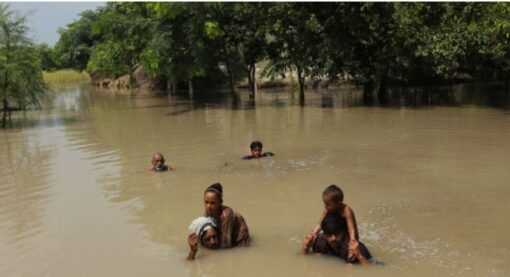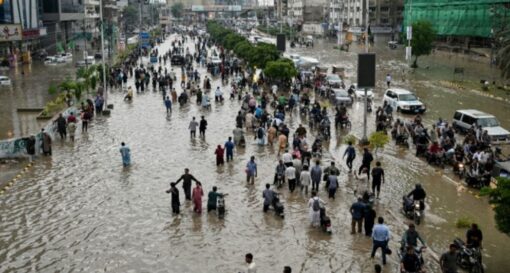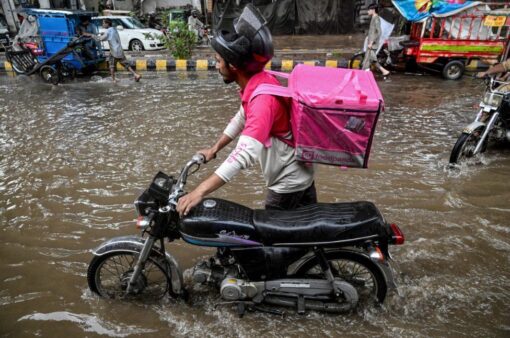South Asia’s monsoon rains have long been a lifeline, feeding agriculture, replenishing rivers, and sustaining over a billion people across India, Pakistan, Nepal, Bangladesh, and Sri Lanka.
But in recent years, that lifeline has begun to look increasingly fragile. The same seasonal rains that once symbolized renewal now often bring devastation, flooding cities, destroying crops, and displacing millions.
In 2025 alone, Pakistan has recorded more than 1,000 deaths due to monsoon flooding—nearly three times the number of lives lost the previous year.
Entire communities have been washed away, food supplies disrupted, and critical infrastructure crippled. Similar tragedies have unfolded in India and Nepal, where flash floods and landslides have devastated villages and agricultural lands.
Experts warn that what is unfolding in South Asia is not an isolated crisis, but a clear sign of how climate change is transforming one of the most important weather systems in the world.
The Science Behind the Monsoon
The word “monsoon” comes from the Arabic word mausim, meaning season. It refers to a shift in prevailing winds that bring moisture-laden air from the oceans onto land, triggering rainfall.
In South Asia, the Southwest Monsoon begins around late May in southern India, gradually sweeping north until September. Later, from October onward, the Northeast Monsoon brings rains to southern India and Sri Lanka.

This seasonal cycle has historically been predictable, allowing farmers to plan sowing and harvesting. But over the last few decades, the reliability of the monsoon has been thrown into question. Scientists have documented longer dry spells punctuated by intense downpours, making rainfall both erratic and extreme.
Between 1950 and 2015, extreme daily rainfall events in India increased by about 75 percent. Government data suggests nearly half of the season’s rain now falls within just a few days, causing floods instead of gradual replenishment.
In Pakistan, the 2025 season started unusually early, with “excessive” rain arriving as early as June, submerging fields and washing away entire settlements.
Climate Change as a Driving Force
Climate experts stress that the monsoon crisis cannot be fully understood without considering climate change. Rising global temperatures are altering weather systems in profound ways.
Warmer seas pump more moisture into the atmosphere, and warmer air can hold greater amounts of water vapor. The result is simple: when it rains, it pours.
Agus Santoso of the University of New South Wales’ Climate Change Research Centre explained that this dynamic is leading to more intense rainfall over shorter periods. Meanwhile, shifting patterns of El Niño and La Niña, themselves increasingly unpredictable due to climate change, are adding volatility to the monsoon system.
While the precise impact of global warming on the monsoon is complex, the evidence points to a future of harsher extremes—prolonged droughts, devastating floods, and cascading impacts on agriculture, health, and infrastructure.

Human and Economic Costs
The monsoon has always been a double-edged sword, bringing both fertility and destruction. Yet, in the current climate crisis, the human and economic costs are rising sharply.
In India’s Punjab region, known as the country’s breadbasket, rainfall surged two-thirds above normal this year, damaging vital crops such as rice and wheat. Erratic rains disrupt irrigation schedules, reduce soil fertility, and create uncertainty for farmers. A delay or failure in monsoon rains can lead to food shortages and economic instability.
In Pakistan, heavy rains have submerged large swaths of farmland, displacing hundreds of thousands. Beyond the immediate toll of deaths and injuries, stagnant floodwaters breed disease and increase the risk of cholera, malaria, and dengue fever. Education, livelihoods, and healthcare in affected areas also collapse under the strain.
The disaster is not confined to rural regions. Cities such as Karachi and Lahore have seen streets turned into rivers, crippling transport and commerce. Even as residents wade through floodwaters, daily life—from food delivery services to schooling—struggles to adapt.
The Role of Development and Infrastructure
Climate change may be a major driver, but poor planning and unregulated development amplify the dangers. The International Centre for Integrated Mountain Development has highlighted how rapid glacier melt, combined with deforestation, is destabilizing rain-soaked slopes, increasing the frequency of deadly landslides.
Meanwhile, highways, tunnels, and dams carved into mountains without adequate environmental safeguards are obstructing natural drainage systems.
Experts such as climate scientist Anjal Prakash argue that unplanned urbanization, river modifications, and ill-placed infrastructure are worsening the monsoon’s impact.
“Rapid, unplanned development destabilises slopes and blocks drainage,” he said, warning that the combination of climate change and reckless expansion is creating a perfect storm.
A Regional Challenge
South Asia’s vulnerability to monsoon extremes is not evenly shared. Countries such as Nepal and Bangladesh, with limited resources and fragile infrastructure, bear an outsized burden.
In Nepal’s Kavre district last year, floods killed over 200 people and displaced thousands more. For Bangladesh, already among the world’s most climate-vulnerable nations, rising sea levels combined with erratic rainfall threaten both cities and farmland.

The crisis also transcends borders because rivers like the Indus, Ganges, and Brahmaputra connect the region. Heavy rainfall in one country can trigger downstream flooding in another, making cross-border cooperation essential. Yet geopolitical tensions often overshadow climate collaboration in South Asia, leaving vulnerable communities without a united response.
Adaptation and Future Solutions
Despite the grim outlook, experts argue that there are pathways to reduce the damage. Investment in resilient infrastructure, early warning systems, and sustainable urban planning could significantly cut disaster risks. Governments across South Asia are slowly waking up to this need, but progress remains uneven.
In India, meteorological advances have improved rainfall forecasting, giving farmers and communities more time to prepare. Pakistan has expanded its disaster management authority, though gaps remain in coordination and resources.
Nepal and Bangladesh are experimenting with community-based disaster preparedness programs that empower local populations to act swiftly during floods.
At a broader level, reducing greenhouse gas emissions remains the only long-term solution to stabilizing climate systems. Without urgent global action, experts warn that the monsoon crisis will escalate, leading to more catastrophic floods, prolonged droughts, and widespread displacement across South Asia.
The Human Face of the Crisis
Behind the statistics and warnings are millions of ordinary people whose lives are being upended. Farmers in Punjab who watch their fields drown, families in Pakistan’s Punjab province forced to abandon homes, children in Nepal missing months of school—all reflect the human cost of a disrupted monsoon.
Stories like that of Abdullah Abbas, a food delivery worker in Lahore who pushed his motorcycle through flooded streets to continue earning a living, highlight the resilience and desperation of communities. For them, climate change is not a distant scientific concept but a daily reality of survival.
A Warning to the World
South Asia’s monsoon crisis is not just a regional issue. It is a warning signal for the world. As climate change accelerates, weather systems globally are becoming more volatile, from hurricanes in the Atlantic to droughts in Africa. The lessons from South Asia are clear: without urgent mitigation and adaptation strategies, billions of lives will be at risk.
The monsoon remains both a blessing and a curse, sustaining life while taking it away. Whether future generations inherit a monsoon that nurtures or one that destroys depends on the choices made today. Governments, communities, and the international community must act with urgency, because the rains are no longer waiting.


